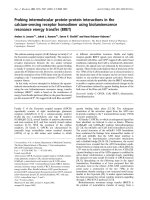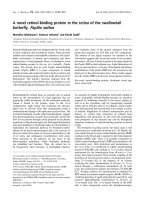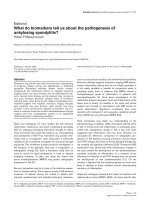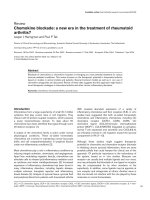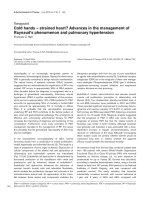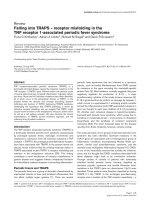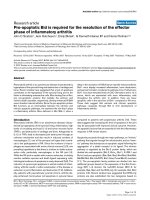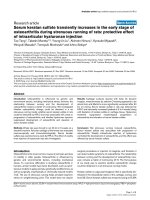Báo cáo y học: "Silencing CD36 gene expression results in the inhibition of latent-TGF-β1 activation and suppression of silica-induced lung fibrosis in the rat" pdf
Bạn đang xem bản rút gọn của tài liệu. Xem và tải ngay bản đầy đủ của tài liệu tại đây (1.84 MB, 9 trang )
BioMed Central
Page 1 of 9
(page number not for citation purposes)
Respiratory Research
Open Access
Research
Silencing CD36 gene expression results in the inhibition of
latent-TGF-β1 activation and suppression of silica-induced lung
fibrosis in the rat
Xin Wang, Ying Chen, Lina Lv and Jie Chen*
Address: Division of Pneumoconiosis, School of Public Health, China Medical University, Shenyang, PR China
Email: Xin Wang - ; Ying Chen - ; Lina Lv - ;
Jie Chen* -
* Corresponding author
Abstract
Background: The biologically active form of transforming growth factor-β1 (TGF-β1) plays a key
role in the development of lung fibrosis. CD36 is involved in the transformation of latent TGF-β1
(L-TGF-β1) to active TGF-β1. To clarify the role of CD36 in the development of silica-induced lung
fibrosis, a rat silicosis model was used to observe both the inhibition of L-TGF-β1 activation and
the antifibrotic effect obtained by lentiviral vector silencing of CD36 expression.
Methods: The rat silicosis model was induced by intratracheal injection of 10 mg silica per rat and
CD36 expression was silenced by administration of a lentiviral vector (Lv-shCD36). The inhibition
of L-TGF-β1 activation was examined using a CCL-64 mink lung epithelial growth inhibition assay,
while determination of hydroxyproline content along with pathological and immunohistochemical
examinations were used for observation of the inhibition of silica-induced lung fibrosis.
Results: The lentiviral vector (Lv-shCD36) silenced expression of CD36 in alveolar macrophages
(AMs) obtained from bronchoalveolar lavage fluid (BALF) and the activation of L-TGF-β1 in the
BALF was inhibited by Lv-shCD36. The hydroxyproline content of silica+Lv-shCD36 treated
groups was significantly lower than in other experimental groups. The degree of fibrosis in the
silica+Lv-shCD36-treated groups was less than observed in other experimental groups. The
expression of collagen I and III in the silica+Lv-shCD36-treated group was significantly lower than
in the other experimental groups.
Conclusion: These results indicate that silencing expression of CD36 can result in the inhibition
of L-TGF-β1 activation in a rat silicosis model, thus further preventing the development of silica-
induced lung fibrosis.
Background
Silicosis is a form of occupational lung disease caused by
inhalation of crystalline silica dust. The pathogenesis of
silicosis involves alveolar cell injury and activation fol-
lowed by cytokine signaling and cell recruitment in the
areas of silica dust deposition [1,2]. The cytokine trans-
forming growth factor-β1 (TGF-β1) plays a critical role in
the progression of lung fibrosis [3-6], and it has been
widely studied with respect to its vital role in the develop-
ment of fibrosis after injury to the lung [7-10].
Published: 13 May 2009
Respiratory Research 2009, 10:36 doi:10.1186/1465-9921-10-36
Received: 21 January 2009
Accepted: 13 May 2009
This article is available from: />© 2009 Wang et al; licensee BioMed Central Ltd.
This is an Open Access article distributed under the terms of the Creative Commons Attribution License ( />),
which permits unrestricted use, distribution, and reproduction in any medium, provided the original work is properly cited.
Respiratory Research 2009, 10:36 />Page 2 of 9
(page number not for citation purposes)
TGF-β1 is synthesized by virtually all cell types in an inac-
tive form referred to as latent TGF-β1 (L-TGF-β1) consist-
ing of the mature TGF-β1 and latent-associated peptide
(LAP). Due to the noncovalently association of mature
TGF-β1 with LAP, the L-TGF-β1 is unable to be recognized
by cell-surface receptors and to trigger biological
responses [5,7,8]. In fact, one of the primary mechanisms
of TGF-β1 regulation is the control of its conversion from
a latent precursor to the biologically active form [11].
CD36, as a receptor of thrombospondin-1 (TSP-1), plays
an important role in the processes of L-TGF-β1 activation.
A number of studies have demonstrated that L-TGF-β1
associates with TSP-1 to form the TSP-1/L-TGF-β1 com-
plex via the specific interaction between LAP and TSP-1.
The TSP-1/L-TGF-β1 complex associates with CD36 on
cell surface via the specific interaction between the YRVR-
FLAKENVTQDAEDNC (93–110) sequence of CD36 and
the sequence CSVTCG (447–452) of TSP-1. Then, L-TGF-
β1 is held at the cell surface by a TSP-1/CD36 interaction
and is processed by plasmin generated by activated alveo-
lar macrophages to produce active TGF-β1. The CD36-
TSP-1/L-TGF-β1 interaction appears critical to the activa-
tion process [12,13]. We presume that silencing expres-
sion of CD36 could inhibit activation of L-TGF-β1 and
result in prevention of the development of lung fibrosis.
A lentiviral vector expressing short hairpin RNA (shRNA)
specific for rat CD36 (Lv-shCD36) was constructed and
shown to suppress expression of CD36 and inhibit the
activation of L-TGF-β1 in a rat alveolar macrophage cell
line called NR8383 (data not shown and will be presented
in another manuscript). In the current study, a rat silicosis
model was generated by intratracheal instillation, and the
inhibitory effects of Lv-shCD36 on the activation of L-
TGF-β1 and the resulting antifibrotic effects were exam-
ined.
Methods
Experimental animals and design
Equal proportions of male and female Wistar rats at 9
weeks of age, weighing 220–240 g, were obtained from
the Center of Experimental Animals, China Medical Uni-
versity (Shenyang, China) with a National Animal Use
License number of SCXK-LN 2003-0009. The animals
were housed at an environmental temperature of 24 ±
1°C and a 12/12 h light/dark cycles, with free access to
food and water. SiO
2
was purchased from Sigma (St.,
Louis, MO, USA). The silica content of the SiO
2
was
>99%, the dust particle size was 0.5–10 μm, and 80% of
the particles were 1–5 μm. Lv-shCD36, a lentiviral vector
expressing shRNA specific against rat CD36, was devel-
oped for a prior study, and it suppressed the expression of
CD36 (data not shown and will be presented in another
manuscript). All experiments and surgical procedures
were approved by the Animal Care and Use Committee at
the China Medical University, which complies with the
National Institute of Health Guide for the Care and Use of
Laboratory Animals.
Animals were divided randomly into the following four
experimental groups (n = 24 per group): (1) saline control
group: instillation of 0.5 ml sterile physiological saline;
(2) silica group: instillation of a suspension of 10 mg sil-
ica dust in a total volume of 0.5 ml sterile physiological
saline; (3) silica+Lv-shCD36 group: instillation of a mixed
suspension of 10 mg silica dust and 5 × 10
8
transducing
units (TU) of Lv-shCD36 in a total volume of 0.5 ml ster-
ile physiological saline; (4) silica+Lv-shCD36-NC group:
instillation of a mixed suspension of 10 mg silica dust and
5 × 10
8
TU Lv-shCD36-NC(non-silence control lentivirus)
in a total volume of 0.5 ml sterile physiological saline.
Rats were anesthetized with an intraperitoneal injection
of 10 mg/rat pentobarbital sodium. The skin of the neck
was opened and blunt dissection exposed the trachea.
Either physiological saline, silica in physiological saline,
or silica with Lv-shCD36 or Lv-shCD36-NC in physiolog-
ical saline, was instilled into the lungs using a 14-gauge
needle inserted into the trachea through the epiglottis of
the larynx. The site of surgery was sutured and the rats
were allowed to recover until they were sacrificed. At 7, 21
and 28 days post-instillation, eight rats of each group were
anesthetized with anesthetic ether, sacrificed by decapita-
tion, and the lungs were removed. Bronchoalveolar lavage
fluid (BALF) was obtained by cannulating the trachea,
injecting and retrieving 3 ml aliquots of sterile physiolog-
ical saline that was centrifuged at 1000 rpm for 1 min at
4°C. The cells were incubated in 1640 medium for 2 h at
37°C in 5% CO
2
, and the adherent cells were mostly alve-
olar macrophages (AMs). After detection of green fluores-
cent protein (GFP) by fluorescence microscopy, AMs were
collected for real-time PCR analysis. The BALF superna-
tant was centrifuged at 3000 rpm for 10 min at 4°C, and
stored at -80°C for later determination of TGF-β1.
Quantitative real-time PCR analysis
Total RNA was isolated from AMs using the Trizol reagent
(Invitrogen, Carlsbad, CA, USA) according to the manu-
facturer's protocol. The sequences of primers specific for
CD36 (sense: 5'-GAAGCACTGAAGAATCTGAAGAG-3';
antisense: 5'-TCCAACACCAAGTAAGACCATC-3'), and β-
Actin (sense: 5'-CGGCATTGTCACCAACTG-3'; antisense:
5'-CGCTCGGTCAGGATCTTC-3'), were synthesized by
Genechem (China). Real-time quantitative PCR (qRT-
PCR) analysis was performed as previously described.
Each PCR reaction mixture (20 μl) contained 10 μl of 2 ×
SYBR Green Master Mix (Takara, Japan), 1 μl of forward
and reverse primers (5 μmol/μl), 1 μl of cDNA product
and water. The PCR reactions were run on iQ5 (Bio-Rad)
using the following program: 95°C for 15 s, and 40 cycles
of 95°C for 5 s and 60°C for 30 s. Following PCR ampli-
Respiratory Research 2009, 10:36 />Page 3 of 9
(page number not for citation purposes)
fication, the reactions were subjected to a temperature
ramp to create a dissociation curve, measured as change in
fluorescence as a function of temperature, which allows
detection of non-specific products. qRT-PCR data were
analyzed using the two standard curve method and β-
Actin was used as an internal control to normalize gene
expression level.
CCL-64 mink lung epithelial growth inhibition assay for
TGF-
β
1
The CCL-64 cell line was grown in Dulbecco's Modified
Eagle's Medium (DMEM, Gibco, USA) with 10% fetal
bovine serum (FBS, Gibco, USA) at 37°C, in 5% CO
2
. To
detect quantities of TGF-β1 in BALF, CCL-64 cells were
plated at 5 × 10
3
cells/well in 96-well plates and cultured
in FBS-free DMEM at 37°C in 5% CO
2
for 4 h. Ten μl of
untreated sample, equivalent to the quantity of TGF-β1
representing active TGF-β1, or treated samples acidified
with HCl and subsequently neutralized with NaOH which
were equivalent to the quantity of TGF-β1 representing
the total TGF-β1 of the same sample, were added to the
wells. The standard curve contained concentrations rang-
ing from 31.25 to 2000 pg/ml of porcine TGF-β1 (R&D
Systems, Minneapolis, USA). The plates were incubated at
37°C in 5% CO
2
for 24 h, then added 10 μl MTT reagent
(5 mg/ml final concentration) to each well for 4 h of incu-
bation. The plates were added 100 μl DMSO to dissolve
the precipitate before analysis at 570 nm using a micro-
plate reader (Bio-Rad 550) [14].
Determination of hydroxyproline content
The lung samples were measured for hydroxyproline con-
tent using a hydroxyproline kit from Nanjing Jian Cheng
Institute (China) following instructions of the manufac-
turer. The results were calculated as micrograms of
hydroxyproline per gram of wet lung weight using hydrox-
yproline standards.
Pathological examination
Following gross inspection of each mouse, small pieces of
lung tissue from the middle of the lobes, in addition to
the hilar lymph nodes, were fixed with 4% paraformalde-
hyde, embedded in paraffin, and sectioned at 5 μm. The
tissue sections were stained with hematoxylin and eosin
(HE) and van Gieson's stain (vG) for collagen fibers. Sili-
cotic nodules were graded as following: cellular nodules
as Stage I; fibrotic cellular nodules as Stage II; cellular
fibrotic nodules as Stage III; fibrotic nodules as Stage IV.
Immunohistochemical staining
For immunohistochemical examination, all sections were
deparaffinized in xylene followed by 100% ethanol and
then placed in a freshly prepared methanol plus 3% H
2
O
2
solution for 30 min to block endogenous peroxidase
activity. After overnight incubation at 4°C with rabbit pol-
yclonal anti-collagen I and III antibodies (Santa Cruz Bio-
technology, Santa Cruz, CA, USA) diluted 1:100 in
phosphate-buffered saline (PBS), antigen-antibody com-
plexes were detected using Streptavidin/Peroxidase (SP)
Histostain™-Plus Kits (Beijing Zhongshan Golden Bridge
Biotechnology Ltd., China). Peroxidase activity was
revealed using a 3, 3'-diaminobenzidine tetrahydrochlo-
ride Substrate Kit (Beijing Zhongshan Golden Bridge Bio-
technology Ltd., China). The sections were counterstained
with hematoxylin for 3 min, rinsed and mounted with
glycerin gelatin for histological examination. Brown parti-
cles in the cytoplasm or the cellular membrane were con-
sidered a positive reaction. The collagen I and III proteins
were analyzed quantitatively using MetaMorph/DP10/
BX41-type image analysis software (UIC/OLYMPUS, US/
JP). In 10 × 40 fields, three to five fields were randomly
selected for each section. The integrated optical density
(IOD) average represented the quantitative expression of
collagens I and III.
Statistical analyses
SPSS 13.0 software was used to conduct statistical analy-
ses. The differences between values were evaluated
through one-way analysis of variance (ANOVA) followed
by pair-wise comparison with the Student-Newman-Keuls
test. P < 0.05 was considered statistically significant.
Results
Lv-shCD36 could silence the expression of CD36 in AMs
AMs were obtained from BALF in each experimental
group at 7 days after instillation. The AMs infected with
either Lv-shCD36 or Lv-shCD36-NC expressed GFP fluo-
rescence, which was detected by fluorescent microscope
[see Additional file 1]. Real-time PCR was performed to
determine the silencing effect of CD36 in AMs in the sil-
ica+Lv-shCD36 group. The results demonstrate that
expression of CD36 mRNA in the silica+Lv-shCD36 group
was significantly lower than in the saline control, silica,
and silica+Lv-shCD36-NC groups (P < 0.05) at 7 days
(Figure 1).
Inhibition of L-TGF-
β
1 activation by Lv-shCD36 in BALF
The activation of L-TGF-β1 was determined by detecting
the quantity of TGF-β1 in BALF using the CCL-64 growth
inhibition assay. The quantities of total TGF-β1 and active
TGF-β1 from BALF in silica group, silica+Lv-shCD36
group and silica+Lv-shCD36-NC group were significantly
higher than those of the saline control group (P < 0.05) at
7 days after the instillations. The quantity of active TGF-β1
from BALF in the silica+Lv-shCD36 group was signifi-
cantly lower than in the silica group or the silica+Lv-
shCD36-NC group (P < 0.05) (Figure 2A-a). The percent
of active TGF-β1 in BALF from each sample was derived
using active TGF-β1 as the numerator and total TGF-β1 as
the denominator. The percent of active TGF-β1 from BALF
Respiratory Research 2009, 10:36 />Page 4 of 9
(page number not for citation purposes)
in the silica+Lv-shCD36 group was significantly lower
than in the silica group or the silica+Lv-shCD36-NC
group (P < 0.05), and it was significantly higher than that
of the saline control group (P < 0.05) (Figure 2A-b). At 21
days after instillation, the quantity of total TGF-β1 and
active TGF-β1 from BALF in the silica group, the silica+Lv-
shCD36 group and the silica+Lv-shCD36-NC group was
decreased compared with the results at 7 days, and they
were significantly higher than the results from the saline
control group (P < 0.05). There were no significant differ-
ences among the silica group, the silica+Lv-shCD36 group
and the silica+Lv-shCD36-NC group (Figure 2B).
Lv-shCD36 could reduce hydroxyproline content in lung
Hydroxyproline content is an important indicator of lung
fibrosis. In this study, no significant differences in the
hydroxyproline content of the four treatment groups were
observed at 7 days after instillation when measured using
a hydroxyproline kit. However, the hydroxyproline con-
tents of the silica group and the silica+Lv-shCD36-NC
group were significantly higher than those of the saline
control group (P < 0.05) at 21 and 28 days after instilla-
tion. The hydroxyproline content of the silica+Lv-shCD36
group was significantly lower than in the silica group and
the silica+Lv-shCD36-NC group (P < 0.05), and signifi-
cantly higher than that of the saline control group (P <
0.05) at 21 and 28 days after instillation (Figure 3).
Lv-shCD36 could inhibit silica-induced lung fibrosis
The lung tissues of rats were observed by light microscope
to monitor pathological changes. No obvious abnormali-
ties were observed in the lungs of rats that received physi-
ological saline. However, in the silica and silica+Lv-
shCD36-NC groups, there was a large infiltration of
inflammatory cells and alveolar septal thickening in the
lung, and occasionally a small amount of cellular nodules
(Stage I) and tiny collagen fibers were observed, at 7 days
after instillation. There were less cellular nodules (Stage I)
in the lungs of rats in the silica+Lv-shCD36 group, and the
vG stain was weakly positive for collagen fibers. At 21 days
after instillation, primarily cellular nodules and fibrotic
cellular nodules (Stage I and II) were observed in the silica
and the silica+Lv-shCD36-NC groups. Some nodules
arranged close and some nodules had loosely distributed
collagen fibers. There were mainly cellular nodules (Stage
I) and tiny collagen fibers in the lung of rats in the sil-
ica+Lv-shCD36 group. Compared to the silica and the sil-
ica+Lv-shCD36-NC groups, the number of nodules in the
lungs of rats in the silica+Lv-shCD36 group was fewer,
and they were smaller. In the silica and the silica+Lv-
shCD36-NC groups, fibrotic cellular nodules (Stage II)
and loosely distributed collagen fibers were observed at
28 days after the instillation. There were still mostly cellu-
lar nodules (Stage I) and tiny collagen fibers in the lungs
of rats from the silica+Lv-shCD36 group, but the number
of nodules was increased (Figure 4, Table 1).
Lv-shCD36 could inhibit the expression of the collagen I
and III in lung
To further observe the degree of fibrosis, immunohisto-
chemical examination of collagen I and III was performed
in the lung tissue. The results showed a weakly positive
reaction for scattered collagen I and collagen III in the
mesenchymal tissue of the saline control group. The
expressions of collagen I and collagen III of the silica+Lv-
shCD36 group were weaker than those of the silica and
silica+Lv-shCD36-NC groups [see Additional file 2 and
Additional file 3]. At the three time points after the instil-
lation, the IOD average of collagen I in the silica and the
silica+Lv-shCD36-NC groups was significantly higher
than that of the saline control groups (P < 0.05). The IOD
average of collagen I in the silica+Lv-shCD36 group was
higher than that of the saline control group (P < 0.05), but
was significantly lower than that of the silica and sil-
ica+Lv-shCD36-NC groups (P < 0.05) (Figure 5A). The
collagen III results were concordant with those of collagen
I (Figure 5B).
Discussion
Lung fibrosis is the most important pathological change
in silicosis. An experimental animal model of silicosis was
induced by an intratracheal administration of silica dust,
resulting in varying degrees of fibrotic silicosis [15]. Fol-
lowing silica-induced lung injury, AMs were stimulated
and they secreted large quantities of biologically active
TGF-β1, which plays a critical role in the development of
lung fibrosis [16-19]. Recent research suggests that a pol-
CD36 mRNA levels from the AMs of each group were detected by realtime-PCRFigure 1
CD36 mRNA levels from the AMs of each group
were detected by realtime-PCR. The expression of
CD36 mRNA in the silica+Lv-shCD36 group was significantly
lower than in the saline control, silica, or silica+Lv-shCD36-
NC groups at 7 days. Each bar represents the mean ± SEM.
*P < 0.05, as compared to saline control group;
Δ
P < 0.05, as
compared to silica group; and
#
P < 0.05, as compared to the
silica+Lv-shCD36-NC group. Data was repeated twice (n =
3) and similar results were obtained.
Respiratory Research 2009, 10:36 />Page 5 of 9
(page number not for citation purposes)
yclonal anti-TGF antibody or the proteoglycan decorin, a
TGF-β1 binding protein, could block TGF-β1 and mark-
edly reduce extracellular matrix accumulation [20-22]. We
hypothesized that it would be also effective to inhibit the
activation of TGF-β1 in an attempt to prevent develop-
ment of silica-induced lung fibrosis.
CD36 may be involved in silica-induced lung fibrosis,
because of its specific combination with TSP-1, which is a
critical factor in the activation of L-TGF-β1 [12]. Accord-
ingly, in our previous work RNAi technology was used to
construct a recombinant lentiviral vector, Lv-shCD36,
which expresses shRNA specific against rat CD36. Lv-
shCD36 was demonstrated to inhibit the activation of L-
TGF-β1 in vivo using the rat alveolar macrophage cell line
NR8383 (data not shown and will be presented in
another manuscript). In the current study, Lv-shCD36 was
used to test for inhibition of L-TGF-β1 activation and an
antifibrotic effect in a rat silicosis experimental model. To
determine effect of Lv-shCD36 on CD36 in the lungs of
Quantity of TGF-β1 and the percentage of active TGF-β1 in BALFFigure 2
Quantity of TGF-β1 and the percentage of active TGF-β1 in BALF. (A–a) The quantity of total and active TGF-β1 in
the silica, silica+Lv-shCD36, and silica+Lv-shCD36-NC groups were significantly higher than in the saline control group at 7
days after instillation. The quantity of active TGF-β1 in the silica+Lv-shCD36 group was significantly lower than in the silica and
silica+Lv-shCD36-NC groups at 7 days. (A–b) The percentage of active TGF-β1 in the silica+Lv-shCD36 group was signifi-
cantly lower than in the silica and silica+Lv-shCD36-NC groups, and it was significantly higher than in the saline control group
at 7 days after instillation. (B–a) The quantity of total and active TGF-β1 in the silica group, the silica+Lv-shCD36 group and
the silica+Lv-shCD36-NC group were significantly higher than in the saline control group at 21 days after instillation. (B–b)
The percentage of active TGF-β1 in the silica group, the silica+Lv-shCD36 group and the silica+Lv-shCD36-NC group were
significantly higher than in the saline control group at 21 days after instillation. Each bar represents the mean ± SEM. **P < 0.05,
as compared to the quantity of total TGF-β1 in the saline control group; *P < 0.05, as compared to the quantity of active TGF-
β1 in the saline control group;
Δ
P < 0.05, as compared to the quantity of active TGF-β1 in the silica group;
#
P < 0.05, as com-
pared to the quantity of active TGF-β1 in the silica+Lv-shCD36-NC group. The data represent the means from experiments
done in six rats.
Respiratory Research 2009, 10:36 />Page 6 of 9
(page number not for citation purposes)
rats, AMs were isolated from BALF seven days after instil-
lation to detect the expression of CD36 mRNA by real
time-PCR. The result suggests that Lv-shCD36 can sup-
press CD36 mRNA expression in the AMs. Examination of
total and active TGF-β1 in the BALF in the early phase of
the experimental silicosis demonstrated that Lv-shCD36
could depress the quantity and percentage of active TGF-
β1. Therefore, we believe that Lv-shCD36 could inhibit
activation of L-TGF-β1 by decreasing expression of CD36
on the membrane of AMs to further reduce the combina-
tion of CD36 with TSP-1/L-TGF-β1.
Activated TGF-β1 can bind its receptor on membrane of
lung fibroblast to regulate collagen synthesis and degrada-
tion that ultimately results in lung fibrosis [8,17]. Inhibit-
ing activation of L-TGF-β1 could suppress development of
silica-induced lung fibrosis. This study shows that the
hydroxyproline content of the silica+Lv-shCD36 group
was significantly lower than the silica and silica+Lv-
shCD36-NC groups at 21 and 28 days after instillation.
The results of immunohistochemical examination of col-
lagen I and III showed that the IOD average of both colla-
gens of the silica+Lv-shCD36 group were significantly
lower than in the silica and silica+Lv-shCD36-NC groups.
Furthermore, the pathological examination revealed an
obviously lighter degree of fibrosis in the silica+Lv-
shCD36 group than in the silica and silica+Lv-shCD36-
NC groups. We conclude that Lv-shCD36 could reduce
pathological tissue fibrosis and collagen accumulation in
the rat model of silicosis, and therefore, it could inhibit
the development of silicosis.
In the experimental lung fibrosis model, the AMs generate
maximal quantities of L-TGF-β1 at 7 days after instillation
of the early phase of lung fibrosis. After L-TGF-β1 was
processed to become active form, the active TGF-β1 starts
the occurrence and development of lung fibrosis. In the
mid and late phases of the experimental lung fibrosis
model, the amount of TGF-β1 released by the AMs
declines gradually [23,24]. In the experimental silicosis
model, there are primarily inflammatory changes and cel-
lular nodules in the early phase. With the development of
fibrosis, there are fibrotic cellular nodules, cellular fibrotic
nodules, even fibrotic nodules in the mid and late phases
of the experimental silicosis [25]. This study also shows
that in the early phase, the quantities of L-TGF-β1 were
obvious high compared with those at 21 days after instil-
lation, and the quantity and percentage of active TGF-β1
were depressed by Lv-shCD36 at 7 days after instillation.
At 21 and 28 days after instillation, the degree of silicosis
was inhibited obviously by Lv-shCD36. Accordingly,
CD36 may participate in the activation process of L-TGF-
β1 in the early phase of the experimental silicosis. Further-
more, silencing expression of CD36 prevented the devel-
opment of silicosis via inhibiting the activation of L-TGF-
Hydroxyproline content of rat lungsFigure 3
Hydroxyproline content of rat lungs. There was no sig-
nificant difference in the hydroxyproline content of the four
groups at 7 days after instillation. The hydroxyproline con-
tent of the silica, the silica+Lv-shCD36, and the silica+Lv-
shCD36-NC groups was significantly higher than that of the
saline control group at 21 and 28 days after instillation. The
hydroxyproline content of the silica+Lv-shCD36 group was
significantly lower than the silica and silica+Lv-shCD36-NC
groups at 21 and 28 days after instillation. Each bar repre-
sents the mean ± SEM. *P < 0.05, as compared to the saline
control group;
Δ
P < 0.05, as compared to the silica group; and
#
P < 0.05, as compared to the silica+Lv-shCD36-NC group.
The data represent the means from experiments done in
eight rats.
Table 1: Silicatic nodule grade of the rat lungs in each group
7 days after instillation 21 days after instillation 28 days after instillation
Groups n Silicotic nodule grade n Silicotic nodule grade n Silicotic nodule grade
Saline control808080
Silica 8 I 8 I ~II 8 II
Silica +Lv-shCD36 8 0 ~I 8 I 8 I
Silica +Lv-shCD36-NC 8 I 8 I ~II 8 II
Respiratory Research 2009, 10:36 />Page 7 of 9
(page number not for citation purposes)
β1. Silicosis patients usually have exposed to low dose of
silica dust for a long time. Silicosis is a chronic and pro-
gressive pathologic reaction. The pathological process of
silicosis occurs and develops repeatedly. So, we presume
that CD36 also repeatedly participates in the activation of
L-TGF-β1 and the pathological process of silicosis. These
results provide a new molecular basis for understanding
latency and activation of L-TGF-β1, which should aid in
the design of novel strategies to suppress silica-induced
lung fibrosis through modulating inappropriate levels of
TGF-β1 activity.
Conclusion
We have shown that silencing expression of CD36 inhib-
its activation of L-TGF-β1, which results in reduced
hydroxyproline, collagen synthesis, and further preven-
tion of the development of lung fibrosis. These effects may
be through the suppression of the association of the TSP-
1/L-TGF-β1 complex with CD36. Our data support the
view that CD36 may contribute to the control of the acti-
vation of L-TGF-β1 and, therefore, silencing expression of
CD36 could inhibit development of silica-induced lung
fibrosis.
Abbreviations
L-TGF-β1: latent transforming growth factor-β1; TSP-1:
thrombospondin-1; shRNA: short hairpin RNA; BALF:
bronchoalveolar lavage fluid; AMs: alveolar macrophages.
Competing interests
The authors declare that they have no competing interests.
HE and vG staining for histopathologic changes in rat lungs (× 400)Figure 4
HE and vG staining for histopathologic changes in rat
lungs (× 400). (A) 7 days after instillation; (B) 21 days after
instillation; (C) 28 days after instillation. a: saline control
group; b: silica group; c: silica+Lv-shCD36; and d: silica+Lv-
shCD36-NC.
IOD average of collagen I and III in the rat lungsFigure 5
IOD average of collagen I and III in the rat lungs. (A)
The IOD averages of collagen I of the silica, the silica+Lv-
shCD36 and the silica+Lv-shCD36-NC groups were signifi-
cantly higher than those of the saline control group at three
time points. The IOD averages of collagen I of the silica+Lv-
shCD36 group were significantly lower than those of the sil-
ica and the silica+Lv-shCD36-NC groups. (B) The IOD aver-
ages of collagen III of the silica, the silica+Lv-shCD36 and the
silica+Lv-shCD36-NC groups were significantly higher than
those of the saline control group at three time points. The
IOD averages of collagen III of the silica+Lv-shCD36 group
were significantly lower than those of the silica and the sil-
ica+Lv-shCD36-NC groups. Each bar represents the mean ±
SEM. *P < 0.05, as compared to the saline control group;
Δ
P <
0.05, as compared to the silica group; and
#
P < 0.05, as com-
pared to the silica+Lv-shCD36-NC group. The data repre-
sent the means from experiments done in six rats.
Respiratory Research 2009, 10:36 />Page 8 of 9
(page number not for citation purposes)
Authors' contributions
XW carried out the experiments, participated in the exper-
imental design and in the interpretation of data, and
drafted the manuscript. YC conceived of the study, partic-
ipated in the analysis of data, helped draft the manuscript.
LL participated in the animal instillation and in the histo-
logical and immunohistochemical experiments. JC initi-
ated the project, participated in the design of the study
and in the interpretation of data, and revised the manu-
script critically.
Additional material
Acknowledgements
We thank technician Ming Zhao for her excellent technical assistance with
the pathological experiments. This work was supported by grants from the
National Natural Science Foundation of China (30500232); the Specialized
Research Fund for the Doctoral Program of Higher Education
(20060159006); and the Liaoning Provincial Natural Science Foundation
(20072102).
References
1. Brown JM, Swindle EJ, Kushnir-Sukhov NM, Holian A, Metcalfe DD:
Silica-directed mast cell activation is enhanced by scavenger
receptors. Am J Respir Cell Mol Biol 2007, 36:43-52.
2. Kühlmann UC, Chwieralski CE, Brule S van den, Röcken C, Reinhold
D, Welte T, Bühling F: Modulation of cytokine production and
silica-induced lung fibrosis by inhibitors of aminopeptidase N
and of dipeptidyl peptidase-IV-related proteases. Life Sci 2009,
84:1-11.
3. Azuma A, Li YJ, Abe S, Usuki J, Matsuda K, Henmi S, Miyauchi Y, Ueda
K, Izawa A, Sone S, Hashimoto S, Kudoh S: Interferon-β inhibits
bleomycin-induced lung fibrosis by decreasing transforming
growth factor-β1 and thrombospondin. Am J Respir Cell Mol Biol
2005, 32:93-98.
4. Cutroneo KR, White SL, Phan SH, Ehrlich HP: Therapies for bleo-
mycin induced lung fibrosis through regulation of TGF-beta1
induced collagen gene expression. J Cell Physiol 2007,
211:585-589.
5. Daniels CE, Wilkes MC, Edens M, Kottom TJ, Murphy SJ, Limper AH,
Leof EB: Imatinib mesylate inhibits the profibrogenic activity
of TGF-β and prevents bleomycin mediated lung fibrosis. J
Clin Invest 2004, 114:1308-1316.
6. Khalil N, Whitman C, Zuo L, Danielpour D, Greenberg A: Regula-
tion of alveolar macrophage transforming growth factor-
beta secretion by corticosteroids in bleomycin-induced pul-
monary inflammation in the rat. J Clin Invest 1993,
92:1812-1818.
7. Chen Y, Chen J, Dong J, Liu W: Antifibrotic effect of Interferon
gamma in silicosis model of rat. Toxicol Lett 2005, 155:353-360.
8. Daniel C, Takabatake Y, Mizui M, Isaka Y, Kawashi H, Rupprecht H,
Imai E, Hugo C: Antisense oligonucleotides against throm-
bospondin-1 inhibit activation of tgf-beta in fibrotic renal dis-
ease in the rat in vivo. Am J Pathol 2003, 163:1185-1192.
9. Xu Q, Norman JT, Shrivastav S, Lucio-Cazana J, Kopp JB: In vitro
models of TGF-{beta}-induced fibrosis suitable for high-
throughput screening of anti-fibrotic agents. Am J Physiol Renal
Physiol
2007, 293:F631-640.
10. Zhou Y, Koli K, Hagood JS, Miao M, Mavalli M, Rifkin DB, Murphy-Ull-
rich JE: Latent Transforming Growth Factor-{beta}-binding
Protein-4 Regulates Transforming Growth Factor-{beta}1
Bioavailability for Activation by Fibrogenic Lung Fibroblasts
in Response to Bleomycin. Am J Pathol 2009, 174:21-33.
11. Abe M, Oda N, Sato Y, Shibata K, Yamasaki M: Augmented binding
and activation of latent transforming growth factor-beta by
a tryptic fragment of latency associated peptide. Endothelium
2002, 9:25-36.
12. Yehualaeshet T, O'Connor R, Green-Johnson J, Mai S, Silverstein R,
Murphy-Ullrich JE, Khalil N: Activation of rat alveolar macro-
phage-derived latent transforming growth factor-β1 by plas-
min requires interaction with thrombospondin- 1 and its cell
surface receptor, CD36. Am J Pathol 1999, 155:841-851.
13. Yehualaeshet T, O'Connor R, Begleiter A, Murphy-Ullrich JE, Silver-
stein R, Khalil N: A CD36 synthetic peptide inhibits bleomycin-
induced pulmonary inflammation and connective tissue syn-
thesis in the rat. Am J Respir Cell Mol Biol 2000, 23:204-212.
14. van Zoelen EJ, van Oostwaard TM, de Laat SW: PDGF-like growth
factor induces EGF-potentiated phenotypic transformation
of normal rat kidney cells in the absence of TGF beta. Bio-
chem Biophys Res Commun 1986, 141:1229-1235.
15. Hemmati AA, Nazari Z, Samei M: A comparative study of grape
seed extract and vitamin E effects on silica-induced pulmo-
nary fibrosis in rats. Pulm Pharmacol Ther 2008, 21:668-674.
16. Cutroneo KR: Evidence for TGF-beta1 and bleomycin intrac-
ellular signaling through autocrine regulation of Smad3 bind-
ing to the proximal promoter of the Smad7 gene. J Cell
Biochem 2006, 97:933-939.
17. Pittet JF, Griffiths MJ, Geiser T, Kaminski N, Dalton SL, Huang X,
Brown LA, Gotwals PJ, Koteliansky VE, Matthay MA, Sheppard D:
TGF-β is a critical mediator of acute lung injury. J Clin Invest
2001, 107:1537-1544.
18. Pulichino AM, Wang IM, Caron A, Mortimer J, Auger A, Boie Y, Elias
JA, Kartono A, Xu L, Menetski J, Sayegh CE: Identification of trans-
forming growth factor beta1-driven genetic programs of
acute lung fibrosis. Am J Respir Cell Molv Biol 2008, 39:324-336.
19. Venkatesan N, Roughley PJ, Ludwig MS: Proteoglycan expression
in bleomycin lung fibroblasts: role of transforming growth
Additional File 1
Expression of GFP in AMs obtained from BALF (× 200). AMs obtained
from BALF at 7 days after instillation, were assayed for GFP expression by
fluorescent microscopy. a) silica+Lv-shCD36 group; b) silica+Lv-
shCD36-NC group. AMs infected with either Lv-shCD36 or Lv-shCD36-
NC expressed GFP fluorescence, demonstrating that the Lv-shCD36 and
Lv-shCD36-NC could infect AMs successfully in vivo.
Click here for file
[ />9921-10-36-S1.tiff]
Additional File 2
Immunohistochemical staining for collagen I at each time point (×
400). 7d: a) saline control group, b) silica group, c) silica+Lv-shCD36,
and d) silica+Lv-shCD36-NC; 21d: e) saline control group, f) silica
group, g) silica+Lv-shCD36, and h) silica+Lv-shCD36-NC; 28d: i)
saline control group, j) silica group, k) silica+Lv-shCD36, and l) sil-
ica+Lv-shCD36-NC. The expression of collagen I in the saline control
group was negative at three time points. The expression of collagen I in the
silica+Lv-shCD36 group was weaker than in the silica group and the sil-
ica+Lv-shCD36-NC group at three time points.
Click here for file
[ />9921-10-36-S2.tiff]
Additional File 3
Immunohistochemical staining for collagen III at each time point (×
400). 7d: a) saline control group, b) silica group, c) silica+Lv-shCD36,
and d) silica+Lv-shCD36-NC; 21d: e) saline control group, f) silica
group, g) silica+Lv-shCD36, and h) silica+Lv-shCD36-NC; 28d: i)
saline control group, j) silica group, k) silica+Lv-shCD36, and l) sil-
ica+Lv-shCD36-NC. The expression of collagen I in the saline control
group was negative at three time points. The expression of collagen III in
the silica+Lv-shCD36 group was weaker than in the silica group and the
silica+Lv-shCD36-NC group at three time points.
Click here for file
[ />9921-10-36-S3.tiff]
Publish with BioMed Central and every
scientist can read your work free of charge
"BioMed Central will be the most significant development for
disseminating the results of biomedical researc h in our lifetime."
Sir Paul Nurse, Cancer Research UK
Your research papers will be:
available free of charge to the entire biomedical community
peer reviewed and published immediately upon acceptance
cited in PubMed and archived on PubMed Central
yours — you keep the copyright
Submit your manuscript here:
/>BioMedcentral
Respiratory Research 2009, 10:36 />Page 9 of 9
(page number not for citation purposes)
factor-beta (1) and interferon gamma. Am J Physiol Lung Cell Mol
Physiol 2002, 283:L806-814.
20. Kolb M, Margetts PJ, Galt T, Sime PJ, Xing Z, Schmidt M, Gauldie J:
Transient transgene expression of decorin in the lung
reduces the fibrotic response to bleomycin. Am J Respir Crit
Care Med 2001, 163:770-777.
21. Kolb M, Margetts PJ, Sime PJ, Gauldie J: Proteoglycans decorin and
biglycan differentially modulate TGF-β mediated fibrotic
responses in the lung. Am J Physiol Lung Cell Mol Physiol 2001,
280:L1327-1334.
22. Wang Q, Hyde DM, Gotwals PJ, Giri SN: Effects of delayed treat-
ment with transforming growth factor-beta soluble receptor
in a three-dose bleomycin model of lung fibrosis in hamsters.
Exp Lung Res 2002, 28:405-417.
23. Khalil N, Bereznay O, Sporn M, Greenberg AH: Macrophage pro-
duction of transforming growth factor beta and fibroblast
collagen synthesis in chronic pulmonary inflammation. J Exp
Med 1989, 170:727-737.
24. Khalil N, Corne S, Whitman C, Yacyshyn H: Plasmin regulates the
activation of cell-associated latent TGF-beta 1 secreted by
rat alveolar macrophages after in vivo bleomycin injury. Am
J Respir Cell Mol Biol 1996, 15:252-259.
25. Gharaee-Kermani M, Ullenbruch M, Phan SH: Animal models of
pulmonary fibrosis. Methods Mol Med 2005, 117:251-259.


